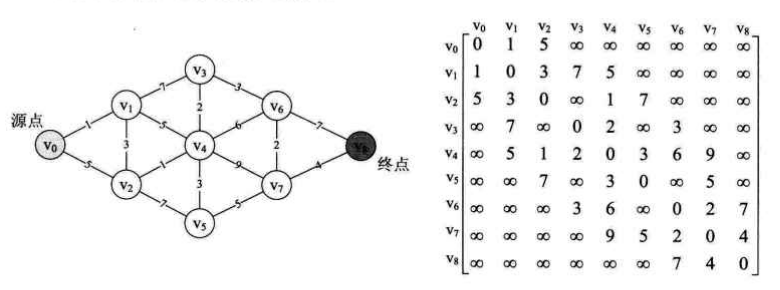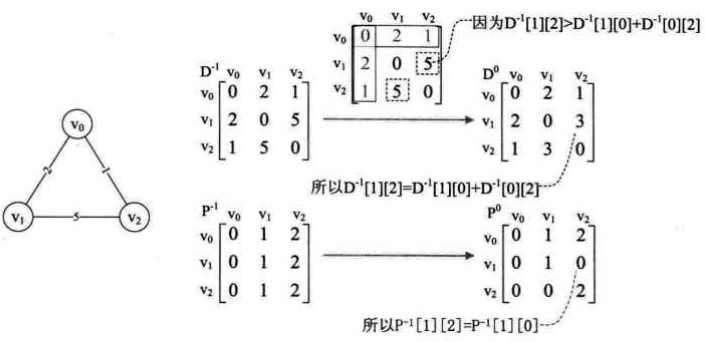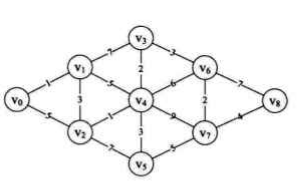一、最短路径的定义
在网图和非网图中,最短路径的含义是不同的。由于非网图没有边上的权值,所谓的最短路径,其实就是指两顶点之间经过的边数最少的路径;而对于网图来说,最短路径是指两顶点之间经过的边上权值之和最少的路径,并且称路径上的第一个顶点是源点,第二个顶点是终点。显然,非网图可以理解为所有的边的权值都为1的网图。
二、Dijkstra算法
1.Dijkstra算法描述
有向网中从源点V0到其他终点的最短路径的过程是:初始情况下,若从源点到该顶点有弧,则存在一条路径,路径长度即为该弧上的权值。每求得一条到达某个终点w的最短路径,就需要检查是否存在经过这个顶点w的其他路径(即是否存在从顶点w出发到尚未求得最短路径顶点的弧),若存在,判断其长度是否比当前求得的路径长度短,若是,则修改当前路径。同时,保存当前已得到的从源点到各个终点的最短路径。
2.Dijkstra算法的C语言代码实现

/* Dijkstra算法,求有向网G的v0顶点到其余顶点v的最短路径P[v]及带权长度D[v] */ /* P[v]的值为前驱顶点下标,D[v]表示v0到v的最短路径长度和 */ void ShortestPath_Dijkstra(MGraph G, int v0, Patharc *P, ShortPathTable *D) { int v,w,k,min; int final[MAXVEX];/* final[w]=1表示求得顶点v0至vw的最短路径 */ for(v=0; v<G.numVertexes; v++) /* 初始化数据 */ { final[v] = 0; /* 全部顶点初始化为未知最短路径状态 */ (*D)[v] = G.arc[v0][v];/* 将与v0点有连线的顶点加上权值 */ (*P)[v] = -1; /* 初始化路径数组P为-1 */ } (*D)[v0] = 0; /* v0至v0路径为0 */ final[v0] = 1; /* v0至v0不需要求路径 */ /* 开始主循环,每次求得v0到某个v顶点的最短路径 */ for(v=1; v<G.numVertexes; v++) { min=INFINITY; /* 当前所知离v0顶点的最近距离 */ for(w=0; w<G.numVertexes; w++) /* 寻找离v0最近的顶点 */ { if(!final[w] && (*D)[w]<min) { k=w; min = (*D)[w]; /* w顶点离v0顶点更近 */ } } final[k] = 1; /* 将目前找到的最近的顶点置为1 */ for(w=0; w<G.numVertexes; w++) /* 修正当前最短路径及距离 */ { /* 如果经过v顶点的路径比现在这条路径的长度短的话 */ if(!final[w] && (min+G.arc[k][w]<(*D)[w])) { /* 说明找到了更短的路径,修改D[w]和P[w] */ (*D)[w] = min + G.arc[k][w]; /* 修改当前路径长度 */ (*P)[w]=k; } } } }
3.Dijkstra算法算法的Java语言代码实现
package bigjun.iplab.adjacencyMatrix; public class TheShortestPath_Dijkstra { private static int[] P; // 若P[v]=w,则表示V0到Vv的最短路径上,顶点Vv的前驱是Vw private static int[] D; // V0到其他各个顶点的最小权值 public final static int INFINITY = Integer.MAX_VALUE; public static void Dijkstra(AdjacencyMatrixGraphINF G, Object V0) throws Exception { int v; int v0 = G.locateVex(V0); int vexNum = G.getVexNum(); // 顶点数 P = new int[vexNum]; D = new int[vexNum]; boolean[] finish = new boolean[vexNum]; // finish[v]=true时,说明已经求得了从v0到v的最短路径 for (v = 0; v < vexNum; v++) { finish[v] = false; D[v] = G.getArcs()[v0][v]; P[v] = -1; } D[v0] = 0; finish[v0] = true; // 已求得v0到v0的最短路径 v = -1; for (int i = 1; i < vexNum; i++) { // 求得V0到顶点Vi的最短路径 int min = INFINITY; for (int w = 0; w < vexNum; w++) { // 求得当前到v0顶点的最近距离 if (!finish[w]) { if (D[w] < min) { v = w; min = D[w]; } } } finish[v] = true; // 在已知V0与V[v]的最短路径的基础上,对V for (int w = 0; w < vexNum; w++) { // 更新当前最短路径及距离 if (!finish[w] && G.getArcs()[v][w] < INFINITY && (min + G.getArcs()[v][w] < D[w])) { D[w] = min + G.getArcs()[v][w]; P[w] = v; } } } System.out.println("V0到其他各个顶点的最短路径的权值之和为: "); for (int i = 1; i < D.length; i++) { System.out.println("V0-" + G.getVex(i).toString() + ": " + D[i]); } System.out.println(); System.out.println("V0到其他各个顶点的最短路径的倒序为: "); for (int i = 1; i < vexNum; i++) { System.out.print("从" + G.getVex(i) + "到V0的最短路径为: "); int j = i; while (P[j] != -1) { System.out.print(G.getVex(P[j]) + " "); j=P[j]; } System.out.println(); } } }
4.Dijkstra算法执行过程的举例说明
以下面的图为例:

测试类:
// 手动创建一个用于测试最短路径算法的无向网 public static AdjacencyMatrixGraphINF createUDNByYourHand_ForTheShortestPath() { Object vexs_UDN[] = {"V0", "V1", "V2", "V3", "V4", "V5", "V6", "V7", "V8"}; int arcsNum_UDN = 16; int[][] arcs_UDN = new int[vexs_UDN.length][vexs_UDN.length]; for (int i = 0; i < vexs_UDN.length; i++) // 构造无向图邻接矩阵 for (int j = 0; j < vexs_UDN.length; j++) if (i==j) { arcs_UDN[i][j]=0; } else { arcs_UDN[i][j] = arcs_UDN[i][j] = INFINITY; } arcs_UDN[0][1] = 1; arcs_UDN[0][2] = 5; arcs_UDN[1][2] = 3; arcs_UDN[1][3] = 7; arcs_UDN[1][4] = 5; arcs_UDN[2][4] = 1; arcs_UDN[2][5] = 7; arcs_UDN[3][4] = 2; arcs_UDN[3][6] = 3; arcs_UDN[4][5] = 3; arcs_UDN[4][6] = 6; arcs_UDN[4][7] = 9; arcs_UDN[5][7] = 5; arcs_UDN[6][7] = 2; arcs_UDN[6][8] = 7; arcs_UDN[7][8] = 4; for (int i = 0; i < vexs_UDN.length; i++) // 构造无向图邻接矩阵 for (int j = i; j < vexs_UDN.length; j++) arcs_UDN[j][i] = arcs_UDN[i][j]; return new AdjMatGraph(GraphKind.UDN, vexs_UDN.length, arcsNum_UDN, vexs_UDN, arcs_UDN); } public static void main(String[] args) throws Exception { AdjMatGraph UDN_Graph_TSP = (AdjMatGraph) createUDNByYourHand_ForTheShortestPath(); TheShortestPath_Dijkstra.Dijkstra(UDN_Graph_TSP, "V0"); }
输出:
V0到其他各个顶点的最短路径的权值之和为: V0-V1: 1 V0-V2: 4 V0-V3: 7 V0-V4: 5 V0-V5: 8 V0-V6: 10 V0-V7: 12 V0-V8: 16 V0到其他各个顶点的最短路径的倒序为: 从V1到V0的最短路径为: 从V2到V0的最短路径为: V1 从V3到V0的最短路径为: V4 V2 V1 从V4到V0的最短路径为: V2 V1 从V5到V0的最短路径为: V4 V2 V1 从V6到V0的最短路径为: V3 V4 V2 V1 从V7到V0的最短路径为: V6 V3 V4 V2 V1 从V8到V0的最短路径为: V7 V6 V3 V4 V2 V1
结合例子分析代码执行过程:

初始化:
v0=0,finish数组都为false,说明所有的点都未求得最短路径,D数组是第一行的权值,P00,10,20,11,22,33为true,D[0]=0,finish[0]= true,v=-1
i=1时,此时D={0,1,5,INF,INF,INF,INF,INF,INF},finish={TFFFFFFFF},v=1,min=D[1]=1,finish[1]=true,
现在V0-V1-V2=D[2]=min+3=4,V0-V1-V3=D[3]=min+7=8,V0-V1-V4=D[4]=min+5=6,
p2=1,p3=1,p4=1
i=2时,此时D={0,1,4,8,6,INF,INF,INF,INF},finish={TTFFFFFFF},v=2,min=D[2]=4,finish[2]=true,
现在V0-V2-V4=D[4]=4+1=5,V0-V2-V5=D[5]=4+7=11,
p4=2,p5=2
i=3时,此时D={0,1,4,8,5,11,INF,INF,INF},finish={TTTFFFFFF},v=4,min=D[4]=5,finish[4]=true,
V0-V4-V3=D[3]=5+2=7,V0-V4-V5=D[5]=5+3=8,V0-V4-V6=D[6]=5+6=11,V0-V4-V7=D[7]=5+9=14,
p3=4,p5=4,p6=4,p7=4
...
i=8时,此时D={0,1,4,7,5,8,10,12,16},finish={TTTTTTTTF},v=8,min=D[8]=16,finish[8]=true,
此时,数组p为:[0,0,1,4,2,4,3,6,7]即由于p8=7,p7=6,p6=3,p3=4,p4=2,p2=1,p1=0得到从V8到V0的倒序为:V8-V7-V6-V3-V4-V2-V1-V0
三、Floyd算法
1.Floyd算法描述
Floyd算法适用于要求所有顶点至所有顶点的最短路径的。其算法思路是:

首先定义左边两个矩阵D和P,D矩阵表示顶点到顶点的最短路径权值之和,P矩阵表示顶点的最小路径的前驱矩阵。
例如,从v1-v0-v2时,从D矩阵可以看出,D[1][0]+D[0][2]=2+1=3,而D[1][2]=5,也就说明v1先到v0再到v2的路径比v1直接到v2的路径权值和要小,所以就要更新D矩阵的[1][2]和[2][1]的值为更小的权值和3,同时由于v1到v2需要经过v0,所以P[1][2]=P[2][1]=0
2.Floyd算法的C语言代码实现

#include "stdio.h" #include "stdlib.h" #include "io.h" #include "math.h" #include "time.h" #define OK 1 #define ERROR 0 #define TRUE 1 #define FALSE 0 #define MAXEDGE 20 #define MAXVEX 20 #define INFINITY 65535 typedef int Status; /* Status是函数的类型,其值是函数结果状态代码,如OK等 */ typedef struct { int vexs[MAXVEX]; int arc[MAXVEX][MAXVEX]; int numVertexes, numEdges; }MGraph; typedef int Patharc[MAXVEX][MAXVEX]; typedef int ShortPathTable[MAXVEX][MAXVEX]; /* 构件图 */ void CreateMGraph(MGraph *G) { int i, j; /* printf("请输入边数和顶点数:"); */ G->numEdges=16; G->numVertexes=9; for (i = 0; i < G->numVertexes; i++)/* 初始化图 */ { G->vexs[i]=i; } for (i = 0; i < G->numVertexes; i++)/* 初始化图 */ { for ( j = 0; j < G->numVertexes; j++) { if (i==j) G->arc[i][j]=0; else G->arc[i][j] = G->arc[j][i] = INFINITY; } } G->arc[0][1]=1; G->arc[0][2]=5; G->arc[1][2]=3; G->arc[1][3]=7; G->arc[1][4]=5; G->arc[2][4]=1; G->arc[2][5]=7; G->arc[3][4]=2; G->arc[3][6]=3; G->arc[4][5]=3; G->arc[4][6]=6; G->arc[4][7]=9; G->arc[5][7]=5; G->arc[6][7]=2; G->arc[6][8]=7; G->arc[7][8]=4; for(i = 0; i < G->numVertexes; i++) { for(j = i; j < G->numVertexes; j++) { G->arc[j][i] =G->arc[i][j]; } } } /* Floyd算法,求网图G中各顶点v到其余顶点w的最短路径P[v][w]及带权长度D[v][w]。 */ void ShortestPath_Floyd(MGraph G, Patharc *P, ShortPathTable *D) { int v,w,k; for(v=0; v<G.numVertexes; ++v) /* 初始化D与P */ { for(w=0; w<G.numVertexes; ++w) { (*D)[v][w]=G.arc[v][w]; /* D[v][w]值即为对应点间的权值 */ (*P)[v][w]=w; /* 初始化P */ } } for(k=0; k<G.numVertexes; ++k) { for(v=0; v<G.numVertexes; ++v) { for(w=0; w<G.numVertexes; ++w) { if ((*D)[v][w]>(*D)[v][k]+(*D)[k][w]) {/* 如果经过下标为k顶点路径比原两点间路径更短 */ (*D)[v][w]=(*D)[v][k]+(*D)[k][w];/* 将当前两点间权值设为更小的一个 */ (*P)[v][w]=(*P)[v][k];/* 路径设置为经过下标为k的顶点 */ } } } } } int main(void) { int v,w,k; MGraph G; Patharc P; ShortPathTable D; /* 求某点到其余各点的最短路径 */ CreateMGraph(&G); ShortestPath_Floyd(G,&P,&D); printf("各顶点间最短路径如下:\n"); for(v=0; v<G.numVertexes; ++v) { for(w=v+1; w<G.numVertexes; w++) { printf("v%d-v%d weight: %d ",v,w,D[v][w]); k=P[v][w]; /* 获得第一个路径顶点下标 */ printf(" path: %d",v); /* 打印源点 */ while(k!=w) /* 如果路径顶点下标不是终点 */ { printf(" -> %d",k); /* 打印路径顶点 */ k=P[k][w]; /* 获得下一个路径顶点下标 */ } printf(" -> %d\n",w); /* 打印终点 */ } printf("\n"); } printf("最短路径D\n"); for(v=0; v<G.numVertexes; ++v) { for(w=0; w<G.numVertexes; ++w) { printf("%d\t",D[v][w]); } printf("\n"); } printf("最短路径P\n"); for(v=0; v<G.numVertexes; ++v) { for(w=0; w<G.numVertexes; ++w) { printf("%d ",P[v][w]); } printf("\n"); } return 0; }
3.Floyd算法算法的Java语言代码实现
package bigjun.iplab.adjacencyMatrix; public class TheShortestPath_Floyd { private static int[][] D; // 顶点到顶点的最短路径权值和矩阵 private static int[][] P; // 顶点的到顶点的最短路径的前驱矩阵 public final static int INFINITY = Integer.MAX_VALUE; public static void Floyd(AdjacencyMatrixGraphINF G) throws Exception { int v, w ,k; int vexNum = G.getVexNum(); P = new int[vexNum][vexNum]; D = new int[vexNum][vexNum]; for (v = 0; v < vexNum; v++) { for (w = 0; w < vexNum; w++) { D[v][w] = G.getArcs()[v][w]; // 初始化D矩阵为邻接矩阵 P[v][w] = w; // 初始化P矩阵,表示从v到w的最短路径的前驱是w,即直接到达的意思 } } for (k = 0; k < vexNum; k++) { // k值表示中转顶点的下标 for (v = 0; v < vexNum; v++) { // v值表示起始顶点的下标 for (w = 0; w < vexNum; w++) { // w值表示终止顶点的下标 if (D[v][k] < INFINITY && D[k][w] < INFINITY && // 注意: 只限定两个不是正无穷就可以,否则会造成越界的情况 D[v][w] > D[v][k] + D[k][w]) { // 从v直接到w的权值和大于从v先到k再到w D[v][w] = D[v][k] + D[k][w]; // 更新从v到w的权值和 P[v][w] = P[v][k]; // 路径设置为经过下标为k的顶点 } } } } System.out.println("D矩阵为: "); for (v = 0; v < vexNum; v++) { for (w = 0; w < vexNum; w++) { System.out.print(D[v][w] + " "); } System.out.println(); } System.out.println(); System.out.println("P矩阵为: "); for (v = 0; v < vexNum; v++) { for (w = 0; w < vexNum; w++) { System.out.print(P[v][w] + " "); } System.out.println(); } System.out.println(); System.out.println("各个顶点之间的最短路径的权值和为: "); for (v = 0; v < vexNum; v++) { for (w = v + 1; w < vexNum; w++) { System.out.print(G.getVex(v) + "-"); System.out.print(G.getVex(w) + " weight: "); System.out.println(D[v][w]); } } System.out.println(); System.out.println("各个顶点之间的最短路径为: "); for (v = 0; v < vexNum; v++) { for (w = v + 1; w < vexNum; w++) { System.out.print(G.getVex(v) + "->"); System.out.print(G.getVex(w) + " TheShortestPath: "); k = P[v][w]; // 获得第一个路径顶点下标 System.out.print(G.getVex(v)); while (k!=w) { System.out.print("->" + G.getVex(k)); k = P[k][w]; } System.out.println("->" + G.getVex(w)); } } System.out.println(); } }
4.Floyd算法执行过程的举例说明
以下面的图为例:


测试代码为:
// 手动创建一个用于测试最短路径算法的无向网 public static AdjacencyMatrixGraphINF createUDNByYourHand_ForTheShortestPath() { Object vexs_UDN[] = {"V0", "V1", "V2", "V3", "V4", "V5", "V6", "V7", "V8"}; int arcsNum_UDN = 16; int[][] arcs_UDN = new int[vexs_UDN.length][vexs_UDN.length]; for (int i = 0; i < vexs_UDN.length; i++) // 构造无向图邻接矩阵 for (int j = 0; j < vexs_UDN.length; j++) if (i==j) { arcs_UDN[i][j]=0; } else { arcs_UDN[i][j] = arcs_UDN[i][j] = INFINITY; } arcs_UDN[0][1] = 1; arcs_UDN[0][2] = 5; arcs_UDN[1][2] = 3; arcs_UDN[1][3] = 7; arcs_UDN[1][4] = 5; arcs_UDN[2][4] = 1; arcs_UDN[2][5] = 7; arcs_UDN[3][4] = 2; arcs_UDN[3][6] = 3; arcs_UDN[4][5] = 3; arcs_UDN[4][6] = 6; arcs_UDN[4][7] = 9; arcs_UDN[5][7] = 5; arcs_UDN[6][7] = 2; arcs_UDN[6][8] = 7; arcs_UDN[7][8] = 4; for (int i = 0; i < vexs_UDN.length; i++) // 构造无向图邻接矩阵 for (int j = i; j < vexs_UDN.length; j++) arcs_UDN[j][i] = arcs_UDN[i][j]; return new AdjMatGraph(GraphKind.UDN, vexs_UDN.length, arcsNum_UDN, vexs_UDN, arcs_UDN); } public static void main(String[] args) throws Exception { AdjMatGraph UDN_Graph_TSP = (AdjMatGraph) createUDNByYourHand_ForTheShortestPath(); TheShortestPath_Floyd.Floyd(UDN_Graph_TSP);
}
输出为:
D矩阵为: 0 1 4 7 5 8 10 12 16 1 0 3 6 4 7 9 11 15 4 3 0 3 1 4 6 8 12 7 6 3 0 2 5 3 5 9 5 4 1 2 0 3 5 7 11 8 7 4 5 3 0 7 5 9 10 9 6 3 5 7 0 2 6 12 11 8 5 7 5 2 0 4 16 15 12 9 11 9 6 4 0 P矩阵为: 0 1 1 1 1 1 1 1 1 0 1 2 2 2 2 2 2 2 1 1 2 4 4 4 4 4 4 4 4 4 3 4 4 6 6 6 2 2 2 3 4 5 3 3 3 4 4 4 4 4 5 7 7 7 3 3 3 3 3 7 6 7 7 6 6 6 6 6 5 6 7 8 7 7 7 7 7 7 7 7 8 各个顶点之间的最短路径的权值和为: V0-V1 weight: 1 V0-V2 weight: 4 V0-V3 weight: 7 V0-V4 weight: 5 V0-V5 weight: 8 V0-V6 weight: 10 V0-V7 weight: 12 V0-V8 weight: 16 V1-V2 weight: 3 V1-V3 weight: 6 V1-V4 weight: 4 V1-V5 weight: 7 V1-V6 weight: 9 V1-V7 weight: 11 V1-V8 weight: 15 V2-V3 weight: 3 V2-V4 weight: 1 V2-V5 weight: 4 V2-V6 weight: 6 V2-V7 weight: 8 V2-V8 weight: 12 V3-V4 weight: 2 V3-V5 weight: 5 V3-V6 weight: 3 V3-V7 weight: 5 V3-V8 weight: 9 V4-V5 weight: 3 V4-V6 weight: 5 V4-V7 weight: 7 V4-V8 weight: 11 V5-V6 weight: 7 V5-V7 weight: 5 V5-V8 weight: 9 V6-V7 weight: 2 V6-V8 weight: 6 V7-V8 weight: 4 各个顶点之间的最短路径为: V0->V1 TheShortestPath: V0->V1 V0->V2 TheShortestPath: V0->V1->V2 V0->V3 TheShortestPath: V0->V1->V2->V4->V3 V0->V4 TheShortestPath: V0->V1->V2->V4 V0->V5 TheShortestPath: V0->V1->V2->V4->V5 V0->V6 TheShortestPath: V0->V1->V2->V4->V3->V6 V0->V7 TheShortestPath: V0->V1->V2->V4->V3->V6->V7 V0->V8 TheShortestPath: V0->V1->V2->V4->V3->V6->V7->V8 V1->V2 TheShortestPath: V1->V2 V1->V3 TheShortestPath: V1->V2->V4->V3 V1->V4 TheShortestPath: V1->V2->V4 V1->V5 TheShortestPath: V1->V2->V4->V5 V1->V6 TheShortestPath: V1->V2->V4->V3->V6 V1->V7 TheShortestPath: V1->V2->V4->V3->V6->V7 V1->V8 TheShortestPath: V1->V2->V4->V3->V6->V7->V8 V2->V3 TheShortestPath: V2->V4->V3 V2->V4 TheShortestPath: V2->V4 V2->V5 TheShortestPath: V2->V4->V5 V2->V6 TheShortestPath: V2->V4->V3->V6 V2->V7 TheShortestPath: V2->V4->V3->V6->V7 V2->V8 TheShortestPath: V2->V4->V3->V6->V7->V8 V3->V4 TheShortestPath: V3->V4 V3->V5 TheShortestPath: V3->V4->V5 V3->V6 TheShortestPath: V3->V6 V3->V7 TheShortestPath: V3->V6->V7 V3->V8 TheShortestPath: V3->V6->V7->V8 V4->V5 TheShortestPath: V4->V5 V4->V6 TheShortestPath: V4->V3->V6 V4->V7 TheShortestPath: V4->V3->V6->V7 V4->V8 TheShortestPath: V4->V3->V6->V7->V8 V5->V6 TheShortestPath: V5->V7->V6 V5->V7 TheShortestPath: V5->V7 V5->V8 TheShortestPath: V5->V7->V8 V6->V7 TheShortestPath: V6->V7 V6->V8 TheShortestPath: V6->V7->V8 V7->V8 TheShortestPath: V7->V8
结合实例分析代码执行过程:


初始化后的D矩阵和P矩阵如上图所示:当K=0时,所有的顶点都经过v0中转,通过计算可以直到没有最短路径的变化
当K=1时,也就是说所有的顶点都经过v1中转,通过比较
D02=5, 而D01+D12=4,所以D02=5,P02=1,也就是说v0到v2要进过v1
D03=INF,而D01+D13=8,所以D03=8,P03=1,
D04=INF,而D01+D14=6,所以D04=6,P04=1,
...同理
要求得v0到v8的路径,已知最后的P矩阵
由p08=1得知要经过v1,由p18=2得知要经过v2,由p28=4得知要经过v4,由p48=3得知要经过v3,由p38=6得知要经过v6,由p68=7得知要经过v7,由p78=8得知要经过v8
从而,得出从v0到v8要经过的路径为:v0-v1-v2-v4-v3-v6-v7-v8
其他同理。
